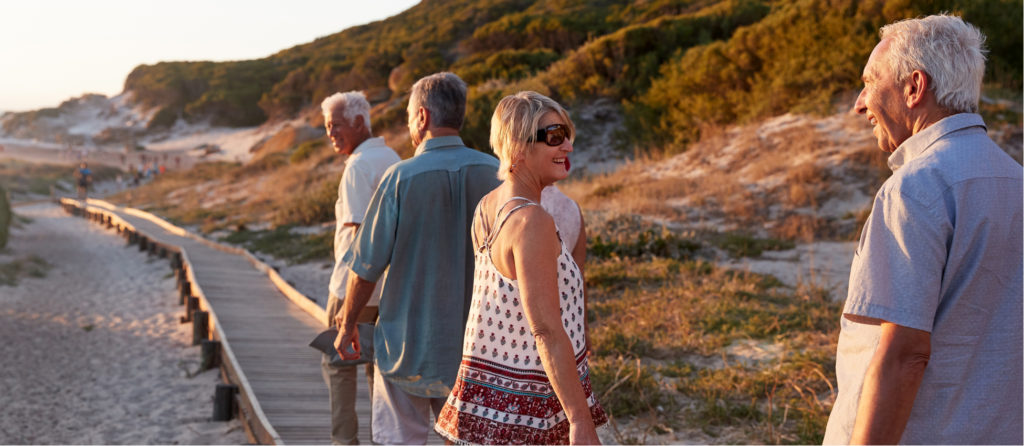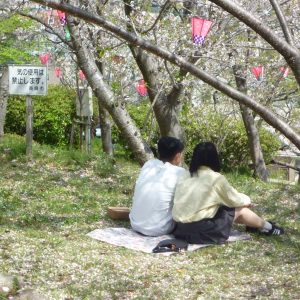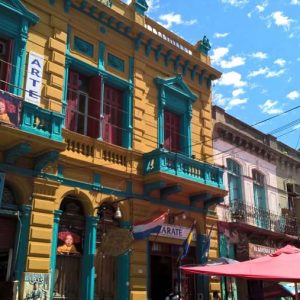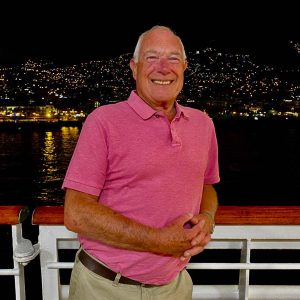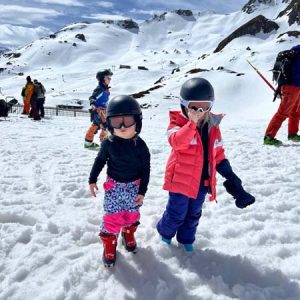The flip flops and the tank
On arrival we were whisked off to see the tunnels at Cu Chi. This labyrinth of underground tunnels, on multiple levels, has its origin in the 1940s and was used by an ill equipped local militia to communicate and avoid capture in the war with France. Repaired and enlarged in the 1960s it is said to stretch 250km and was largely responsible for the Viet Cong holding a significant area against South Vietnamese and American forces. Whilst war is always a sobering topic, we couldn’t fail to admire the ingenuity in coming up with different ways to conceal themselves and oppose a force that was throwing millions of dollars of ordinance at them. 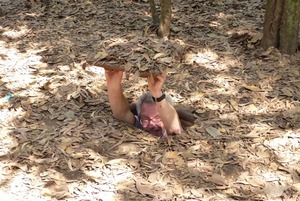 The tunnels were not just for getting about, hiding and communication but incorporated kitchens, workshops, dormitories and infirmaries, all expertly camouflaged. I got to try out a hide hole which consisted of a wooden trapdoor under a large area of leaves and even though I knew where it was, I had trouble finding it (see photo). I also navigated a stretch of tunnel which, enlarged for westerners to try, was decidedly claustrophobic. The ingenuity included some fairly barbaric booby traps, made from unexploded bombs, plus practical items like flip flops made from used tyres.
The tunnels were not just for getting about, hiding and communication but incorporated kitchens, workshops, dormitories and infirmaries, all expertly camouflaged. I got to try out a hide hole which consisted of a wooden trapdoor under a large area of leaves and even though I knew where it was, I had trouble finding it (see photo). I also navigated a stretch of tunnel which, enlarged for westerners to try, was decidedly claustrophobic. The ingenuity included some fairly barbaric booby traps, made from unexploded bombs, plus practical items like flip flops made from used tyres.
On a lighter note, it’s time I dealt with the subject of traffic in Saigon. With a population in excess of 7m, there are more cars here and a greater volume of traffic than we’ve encountered to date. Whilst perhaps slightly more orderly than some places, it’s still a shock to us largely rule following westerners. So consider this for your trip; zebra crossings are more a piece of street art than any help in crossing and a t-shirt we saw in the market sums it up so well. Traffic lights in Vietnam:
Green = I can go
Amber = I can go
Red = I can still go
Crossing the road (all part of the fun once you get your head around it) we turned the corner and found the Notre DameCathedral. We thought we’d taken a wrong turn and ended up in France, but this 1880s brick construction is still looking fairly pristine (in contrast with some of its European counterparts) and reflects the strong French influence in the city. Across the road we admired some work by Gustave Eiffel, who designed the Central Post Office with its delightful curved ceiling, mosaic, tiled floor and historic maps painted on the walls. 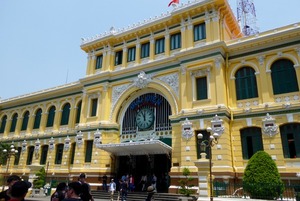 It also had some old style wooden telephone boxes, perfect for me to change into my superman outfit.
It also had some old style wooden telephone boxes, perfect for me to change into my superman outfit.
Time for a break and our exploration of Vietnamese coffee continued in a lovely little coffee house just off the market. Greeted with a complimentary iced green tea, we chose iced coffee Vietnamese style to go with it. The filter coffee drips into a glass with a little condensed milk in it, when finished pour the hot liquid into a glass of ice, stir and consume. Absolutely brilliant when it’s 33C outside.
Suitably refreshed, we visited the Reunification Palace. Possibly etched in most people’s minds as the place where General Minh’s tanks crashed through the wrought iron gates to mark the fall of Saigon (remember Sandy Gall reporting on it?). Although the tanks are in the grounds, they don’t reenact this event to amuse the tourists, instead you get to peruse this quite lovely 1960s building, one of many that have stood on the site. Previous incarnations were built for the French Governor General and inherited by the South Vietnamese president. So hated was Ngo Dinh Diem that one of his air force pilots bombed the palace in 1962 to try to dispose of him. 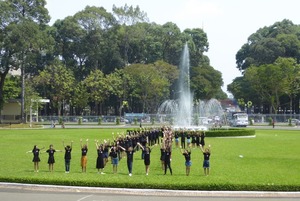 The current building is beautifully designed so that the air flows through the building, making it open and refreshingly cool even without air conditioning. Opulent rooms and a balcony that enjoys views over the lawn with a fountain, tell a tale of a lifestyle inside the palace that was very different from the lifestyle outside.
The current building is beautifully designed so that the air flows through the building, making it open and refreshingly cool even without air conditioning. Opulent rooms and a balcony that enjoys views over the lawn with a fountain, tell a tale of a lifestyle inside the palace that was very different from the lifestyle outside.
Part of the fun of exploring a big city is to just wander and mingle with the locals. We found the people of Saigon very friendly and much more tactile that in our cities. Wandering through the crowded spaces of the market you’d often catch a friendly smile and/or a brief touch on the arm. One guy even gave me a friendly squeeze on the back – imaging trying that one in London! Rice is such an important part of the diet here that there were more varieties of rice here than I even knew existed. Western imports can be confusing, so informative signs explain that western toilets are for sitting on, not squatting (see photo).
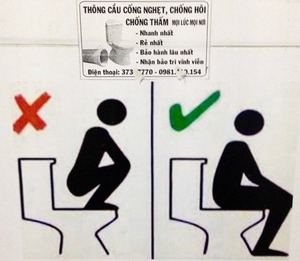 Before our nighttime excursions it was back to the hotel to freshen up and we were staying at the Liberty Central Saigon Citypoint. It was a lovely modern hotel in a great position right in the heart of things. The staff were lovely and it had all the modern facilities you would expect for a comfortable base in the city. The stand out item had to be the bed, which was the biggest I’d ever seen. Even when I laid left to right, there was still two feet of bed space left, bigger than a king size, perhaps this was monster size.
Before our nighttime excursions it was back to the hotel to freshen up and we were staying at the Liberty Central Saigon Citypoint. It was a lovely modern hotel in a great position right in the heart of things. The staff were lovely and it had all the modern facilities you would expect for a comfortable base in the city. The stand out item had to be the bed, which was the biggest I’d ever seen. Even when I laid left to right, there was still two feet of bed space left, bigger than a king size, perhaps this was monster size.
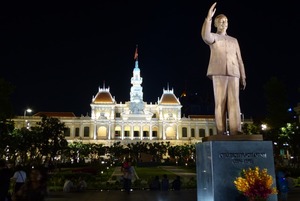 Ho Chi Minh City is no slouch when the sun goes down and can hold its own with many a big city as far as illuminations go. Aside for the more garish neon lighting, I was more impressed by the statue of Ho Chi Minh against the backdrop of the People’s Committee building. Both tastefully lit and worth standing and admiring for a few moments.
Ho Chi Minh City is no slouch when the sun goes down and can hold its own with many a big city as far as illuminations go. Aside for the more garish neon lighting, I was more impressed by the statue of Ho Chi Minh against the backdrop of the People’s Committee building. Both tastefully lit and worth standing and admiring for a few moments.
Before dark though, we’d settled into the bar at the 68 story Bitexco Financial tower. Described in the Lonely Planet guide book as looking like ‘a CD rack with a tambourine shoved into it’, that didn’t matter as we enjoyed the hazy sunset, sipped our cocktails and watch the lights of Saigon blink on. Next stop was the Mekong delta, so we suspected things might get a little more rustic from this point.
Silver Travel Advisor recommends Selective Asia
- Indochina with Selective Asia – Chapter 1: Hanoi
- Indochina with Selective Asia – Chapter 2: Halong Bay and Hue
- Indochina with Selective Asia – Chapter 3: Hue and Hoi An
- Indochina with Selective Asia – Chapter 5: Mekong Delta
- Indochina with Selective Asia – Chapter 6: Phnom Penh
- Indochina with Selective Asia – Chapter 7: Siem Reap
- Indochina with Selective Asia – Chapter 8: Luang Prebang
